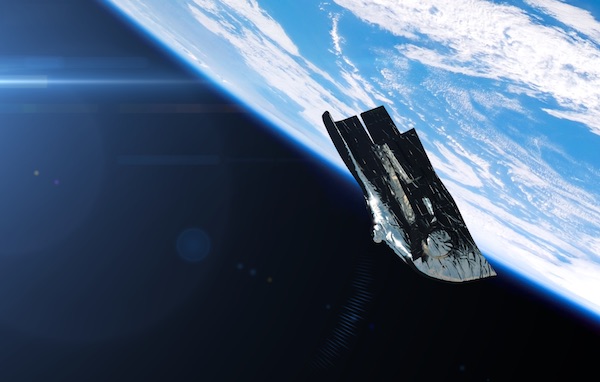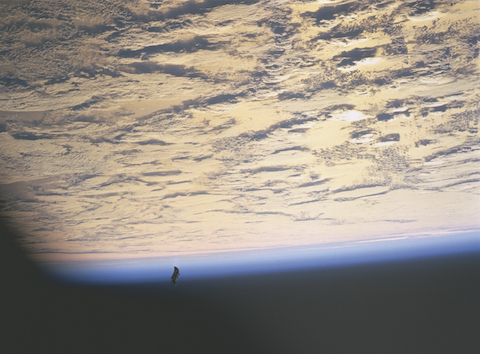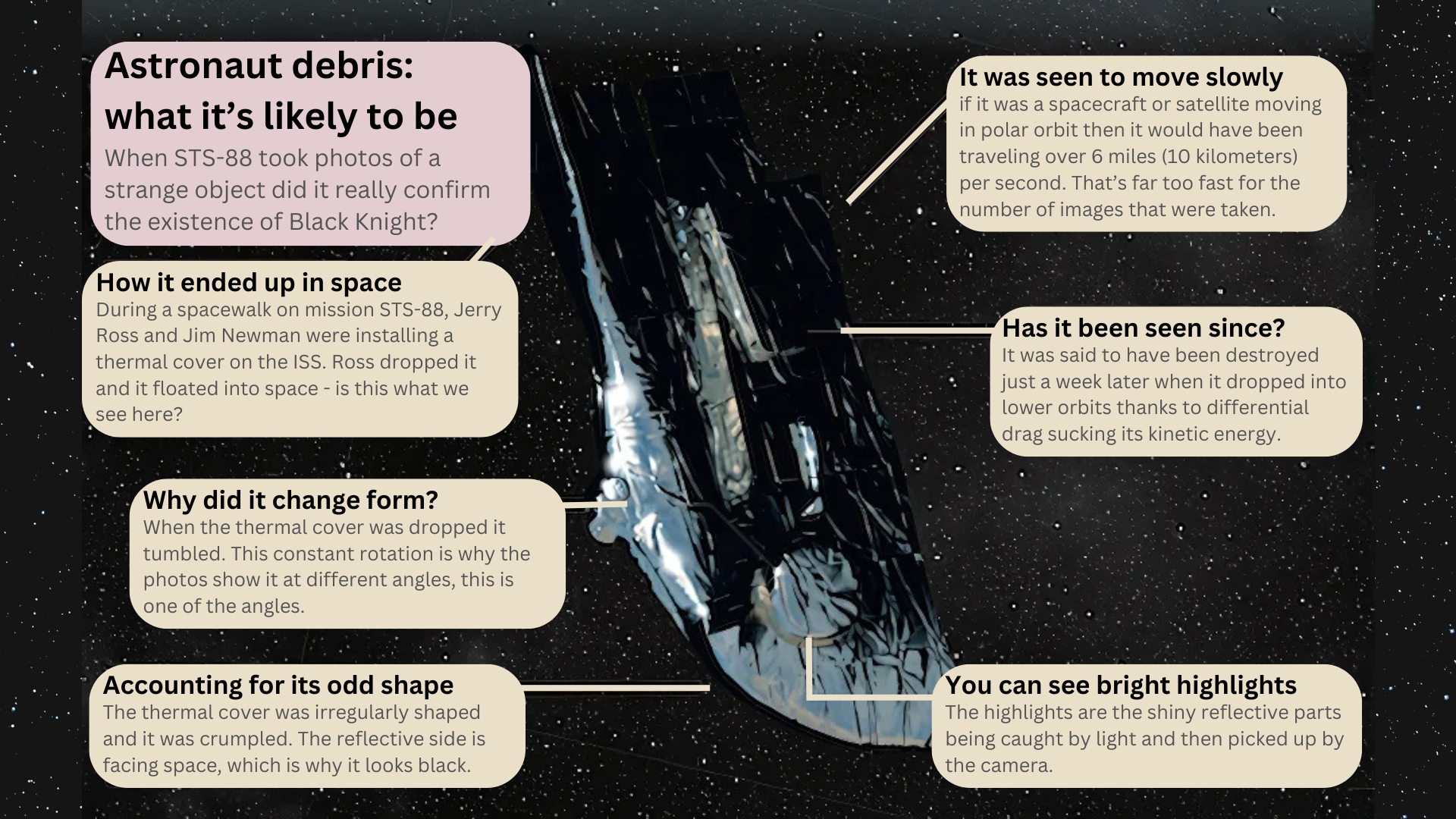The 'Black Knight' satellite conspiracy: Uncovering the 120-year-old alien mystery
According to conspiracy theorists, the Black Knight satellite is an alien spacecraft orbiting Earth. Here's what's really going on.

Some news report introductions are so unexpected that they make you pause and reread to ensure you understood them correctly. This was the case on March 21, 2017, when the Mail Online reported: "An alien satellite set up more than 12,000 years ago to spy on humans has been shot down by elite soldiers from the illuminati, UFO hunters claim."
With that, the conspiracy surrounding the so-called "Black Knight" satellite appeared to be alive and well.
It's been more than 120 years, conspiracists believe, since the existence of the Black Knight was first recorded. Those who subscribe to the theory invoke an extraterrestrial spacecraft in near-polar orbit of Earth, although they draw upon pieces of evidence so disparate that it's not entirely clear why people link them. What it all amounts to is a strange brew that has spurred some folks to shout about cover-ups by NASA and other government entities. It's a legend that refuses to go away.
UFOs and UAP: History, sightings and mysteries
What is the Black Knight satellite?
A lot of the earliest discoveries that have been linked to the Black Knight satellite theory relate to radio signals. But a series of images from 1998 really threw the celestial cat among the pigeons. They were taken during STS-88, the first space shuttle mission to the International Space Station (ISS).
There, for all to see, were images released by NASA that showed a black object hovering above our planet in low Earth orbit. And it wasn't long after the images were thrust in front of a hopeful public before people were performing some conspiratorial sums and sharing them with the wider world.
By way of explanation, STS-88 astronaut Jerry Ross pointed out that the ISS was in the midst of being constructed when the images were taken. The U.S. team, he said, was on its way to attach the American module to the one created by the Russians and, as part of that work, they had taken four trunnion pin thermal covers with them. The task was to wrap these around four bare trunnion pins, these being rods that attached the module to the space shuttle Endeavour while it was being transported. This would act to prevent heat loss from the exposed metal.
Expedition 58: The International Space Station mission in pictures

Unfortunately, during one of the spacewalks associated with this work, things went a little bit wrong: One of the covers came loose from its tether, causing it to float away along with some other items.
"Jerry, one of the thermal covers got away from you," STS-88 commander Robert Cabana (who now serves as associate administrator of NASA) told Ross during the spacewalk, and it soon became apparent that the cover was lost for good.

Subsequently captured on camera, this runaway black object was given the catalog number 025570 by NASA. A few days later, the item fell from orbit and burned up.
Much of this information has been placed on the record. Former NASA engineer James Oberg, who personally knows Ross and the person who took the photos, cosmonaut Sergei Krikalev, has demonstrated that these supposed images of the Black Knight actually depict a very mundane object.
Related: The most extreme human spaceflight records
James Oberg is a space journalist, historian and former NASA engineer who personally knows Ross and the person who took the photos, cosmonaut Sergei Krikalev. Oberg frequently addresses supposed UFO sightings, offering scientific interpretations for phenomena that may appear extraterrestrial or debunking them as hoaxes.
"Before leaving NASA, I led the trajectory design team that produced the mission profile," Oberg told All About Space Magazine.
"Every step of the way, there is consistency with what I learned as a lifelong spaceflight operations specialist: why the blankets were needed, why one of them came loose, why it floated off the way it did," he added. "The difference is, for the general public all these features are unearthly to folks who are only familiar with Earthside principles of heating, working, motion and dozens of other never-before-encountered-in-history aspects of outer space."

Given Oberg's thorough debunking, you'd think the matter would have been put to bed long ago. But no. Since the images were shared far and wide, conspiracy theories have lingered.
"They are probably some of the weirdest-looking 70-mm photos to ever come out of the space shuttle program," Oberg said. “And apparently a NASA website update made the original links inoperative, sparking concerns over a cover-up. All normal journalistic practices — determining the timeline, asking witnesses, searching for the wider context — were skipped."
Other 'evidence'
Conspiracists absorbed the STS-88 images into a growing body of "evidence," claiming they were proof that the Black Knight alien satellite really is out there.
Reaching that conclusion, however, has required great leaps of faith, and has also needed past observations to be forced into the overall story. Firm believers have had no problems going all the way back to 1899 in pursuit of such "truth," but, just like the photographic records, each piece of supposed evidence brought to the table so far has been explained just fine without falling back on the Black Knight myth.
So what happened in 1899? Nikola Tesla began to record some very odd signals, seemingly from outer space. While in his barn-like laboratory in Colorado Springs that year, the genius Serbian-American inventor and electrical engineer noted some unusual radio signals and speculated they had come from an intelligent alien civilization.
That's perhaps the least likely explanation, of course. Over the years, some people have speculated that Tesla may have detected emissions from a pulsar, a superdense, fast-spinning stellar corpse. But that's probably off the mark as well, scientists say.
"The very first source of non-terrestrial radio waves was discovered in the 1930s, and that was from the center of our galaxy, which is the most powerful radio source in the sky at many frequencies," said Varoujan Gorjian, a scientist at NASA's Jet Propulsion Laboratory in Southern California. "It wasn’t until the 1960s that the technology evolved to detect the first pulsars. If what Tesla detected was a real signal and not an artifact of his instrument, it most likely came from Earth."
Related: Fermi paradox: Where are the aliens?
Why do people think the Black Knight satellites exists?
People continued to use Tesla's findings to bolster claims for the Black Knight. They also took on board the work of a Norwegian engineer called Jørgen Hals, who in the 1920s found that radio signals he transmitted were being echoed back to him a few seconds later. We now know these as long-delayed echoes, and Hals was the first person to observe them.
The fact that we don't have a confirmed explanation of their cause, however, has been seized upon: In 1973, Duncan Lunan wrote an article in Spaceflight magazine suggesting that people studying long-delayed echoes had overlooked the possibility they were sent by an alien space probe.
Lunan still has faith in an extraterrestrial explanation for the recordings.
"The changes in the long-distance echo patterns in apparent response to changes in the outgoing signals from Earth really do look like the responses of a Bracewell probe, and there is still no satisfactory natural explanation for the phenomenon," he said, referring to a hypothesized autonomous spacecraft designed to communicate with other civilizations.
If the long-distance echoes were deliberately produced by a probe, however, there's a problem in that they stopped in 1975.
"If a probe was monitoring Earth, rather than trying to attract attention, perhaps it belatedly discovered from the 1973 to 1974 publicity that it had given away its presence in the 1920s and pulled out in 1975," Lunan said. "That's the only explanation I can see for its apparent departure."
And yet, for all of that, Lunan said his research has nothing to do with the "Black Knight nonsense." If there is a link between his theory and the Black Knight, it is not one that is being made by him.
Related: 13 ways to hunt intelligent aliens
A growing interest in UFOs and UAPS
The Black Knight conspiracy theory may be with us for a while yet, for there is a growing public interest in unidentified flying objects (UFOs) — or, as the US military has recently rebranded them, unidentified aerial phenomena (UAP).
This interest really began to surge in December 2017, when The New York Times published three videos captured by cameras aboard US Navy jets. The footage showed objects that appeared to maneuver in ways beyond the capabilities of known technology.
That New York Times story also discussed the Advanced Aerospace Threat Identification Program (AATIP), a previously secret US military project looking into UFOs. Politico and The Washington Post published their own pieces about AATIP around that same time, adding to the UFO momentum.
AATIP officially lasted just from 2007 to 2012. But in 2020, the military announced a successor program called the Unidentified Aerial Phenomena Task Force, whose mission is "to detect, analyze and catalog UAPs that could potentially pose a threat to US national security."
This is a very practical concern for military officials. For example, what if some of the mysterious objects are alarmingly advanced reconnaissance craft developed by adversary nations?
In 2022, NASA commissioned an independent panel of experts to inform NASA and other government agencies how better data might be collected and analyzed by in an attempt to understand UAPs.
The first report was released on Sept. 14, 2023.
"The top takeaway from the study is that there is a lot more to learn," NASA Administrator Bill Nelson said Thursday (Sept. 14) while releasing the report. "The NASA independent study team did not find any evidence that UAP have an extraterrestrial origin, but we don't know what these UAP are."
So there is some real intrigue and mystery surrounding UFOs, some of which are difficult to explain. But that mystery does not extend to the Black Knight, a wayward thermal blanket that burned up in Earth's atmosphere more than two decades ago.
Additional resources:
- Learn about why people believe in conspiracy theories.
- Read about the life and discoveries of Nikola Tesla.
- Read more from James Oberg about STS-88 and the dropped thermal blanket.
Join our Space Forums to keep talking space on the latest missions, night sky and more! And if you have a news tip, correction or comment, let us know at: community@space.com.
Get the Space.com Newsletter
Breaking space news, the latest updates on rocket launches, skywatching events and more!

David Crookes is a UK-based science and technology journalist who has been writing professionally for more than two decades. Having studied at the University of Durham in England, he has written for dozens of newspapers, magazines and websites including The Independent, The i Paper, London Evening Standard, BBC Earth, How It Works and LiveScience. He has been a regular contributor to Space.com's sister publication, All About Space magazine since 2014.











